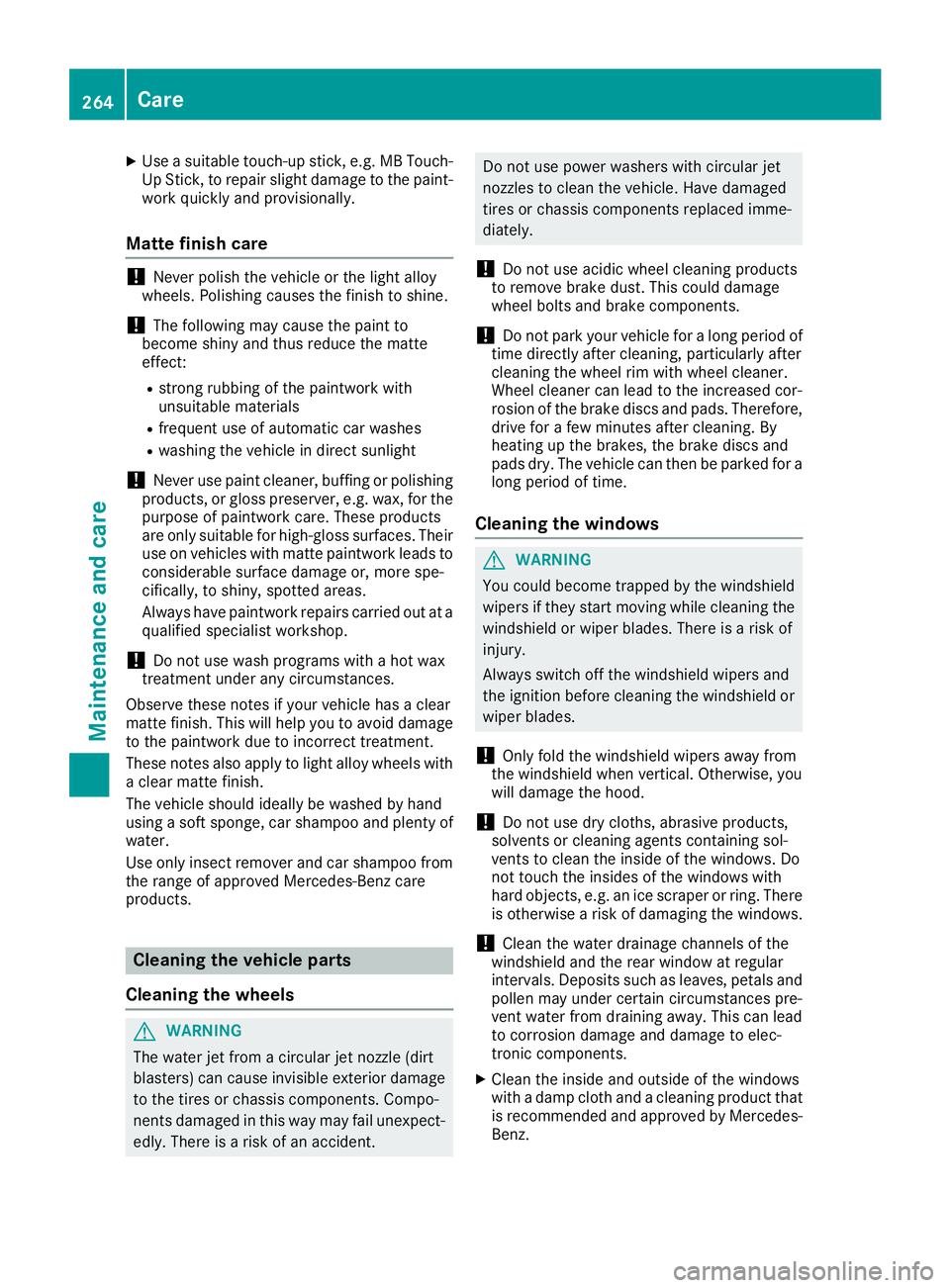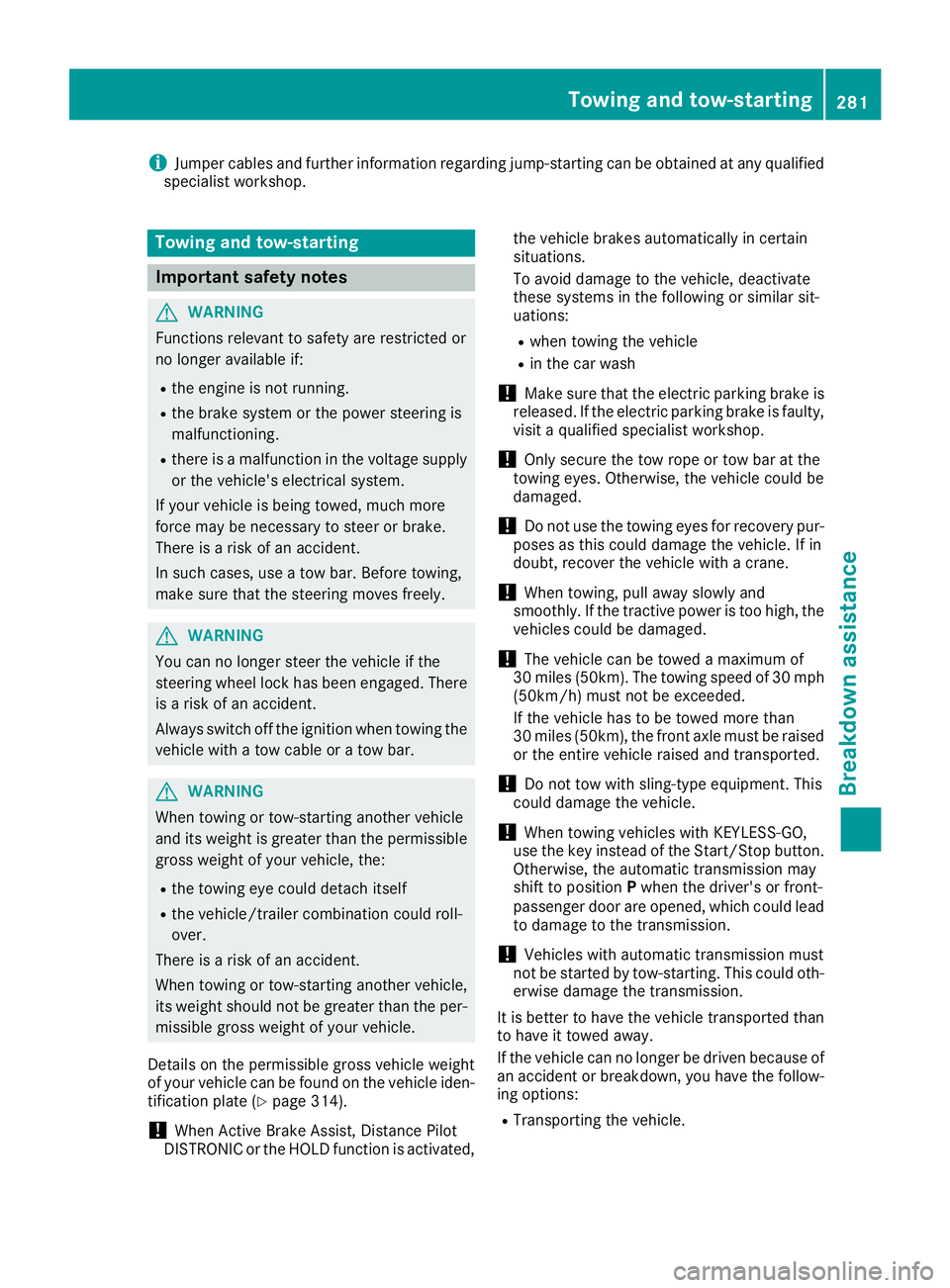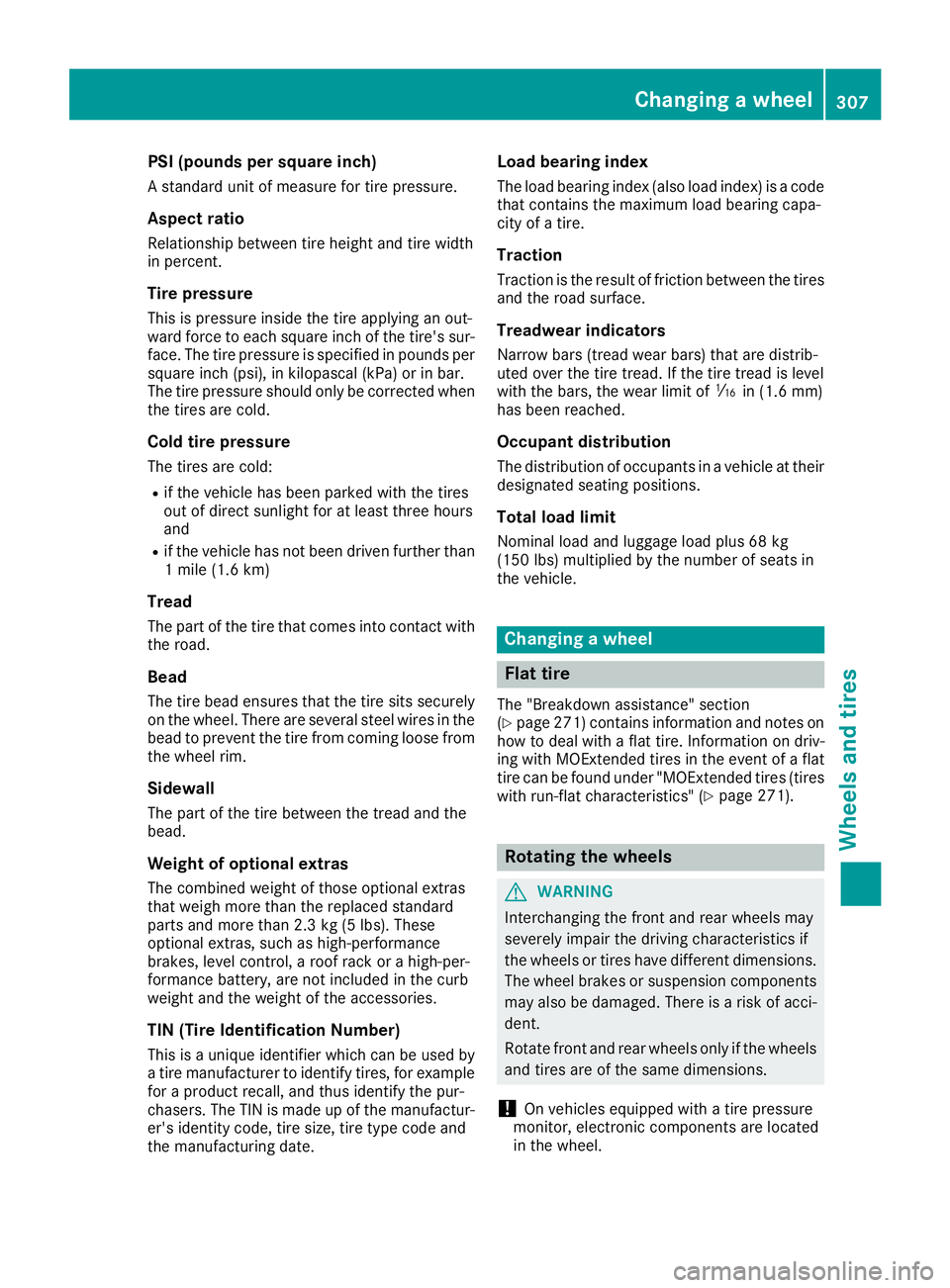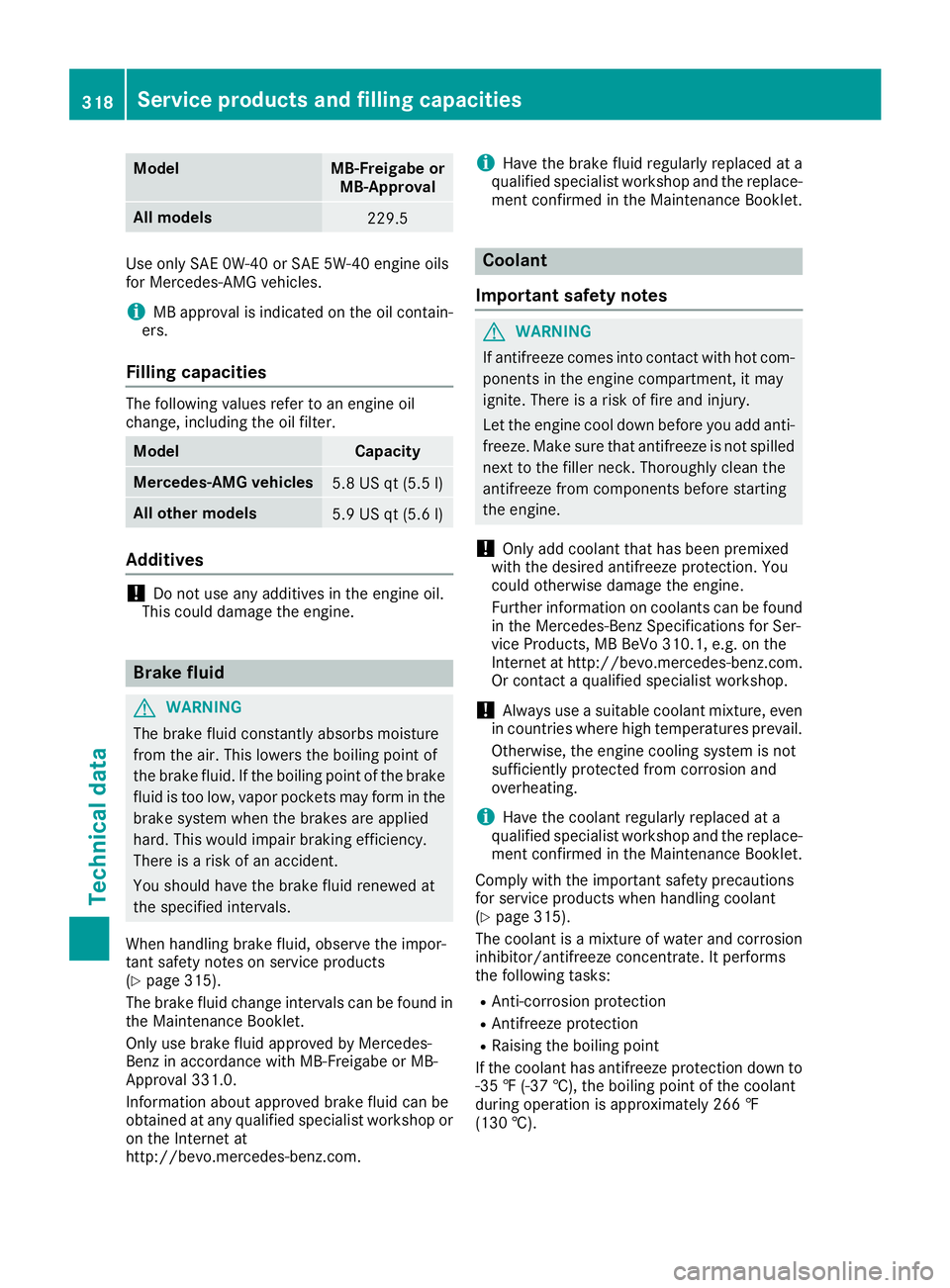2018 MERCEDES-BENZ CLA brakes
[x] Cancel search: brakesPage 266 of 326

X
Use as uitabl et ouch-up stick, e.g. MB Touch-
Up Stick ,tor epair slight damage to the paint-
work quickly and provisionally.
Matt ef inish care
! Never polish the vehicle or the light alloy
wheels. Polishing causes the finish to shine.
! The following may cause the paint to
become shiny and thus reduce the matte
effect: R
strong rubbing of the paintwork with
unsuitabl em aterialsR
frequent use of automatic car washes R
washing the vehicle in direct sunlight
! Never use paint cleaner, buffing or polishing
products, or gloss preserver, e.g. wax, for the
purpose of paintwork care. These products
are only suitabl ef or high-gloss surfaces. Their
use on vehicles with matte paintwork leads to
considerable surface damage or, more spe-
cifically ,tos hiny, spotted areas.
Alway sh ave paintwork repairs carried out at a
qualified specialist workshop.
! Do not use wash programs with ah ot wax
treatment under any circumstances.
Observe these notes if your vehicle has ac lear
matte finish. This will help you to avoid damage
to the paintwork due to incorrect treatment.
These notes also apply to light alloy wheels with
ac lear matte finish.
The vehicle should ideally be washed by hand
using as oft sponge, car shampoo and plenty of
water.
Use only insect remover and car shampoo from
the range of approved Mercedes-Benz care
products.
Cleaning the vehicl ep arts
Cleaning the wheels
G WARNING
The water jet from ac ircular jet nozzle (dirt
blasters) can cause invisible exterior damage
to the tires or chassis components. Compo-
nent sd amage dint his way may fail unexpect-
edly .T here is ar isk of an accident. Do not use power washers with circular jet
nozzles to clean the vehicle. Have damaged
tires or chassis component sr eplaced imme-
diately.
! Do not use acidic wheel cleaning products
to remove brake dust. This could damage
wheel bolts and brake components.
! Do not park your vehicle for al ong period of
time directly after cleaning, particularl ya fter
cleaning the wheel rim with wheel cleaner.
Wheel cleaner can lead to the increased cor-
rosion of the brake discs and pads. Therefore,
drive for af ew minutes after cleaning. By
heating up the brakes, the brake discs and
pads dry. The vehicle can then be parked for a
long period of time.
Cleaning the windows
G WARNING
You could become trapped by the windshield
wipers if they start moving while cleaning the
windshiel dorw iper blades. There is ar isk of
injury.
Alway ss witch off the windshiel dw ipers and
the ignition before cleaning the windshiel do r
wiper blades.
! Only fold the windshiel dw ipers awa yf rom
the windshiel dw hen vertical. Otherwise, you
will damage the hood.
! Do not use dry cloths, abrasive products,
solvents or cleaning agents containing sol-
vents to clean the inside of the windows. Do
not touch the insides of the windows with
hard objects, e.g. an ice scraper or ring. There
is otherwise ar isk of damaging the windows.
! Clea nt he water drainage channels of the
windshiel da nd the rear window at regular
intervals. Deposits such as leaves, petals and
pollen may under certain circumstances pre-
vent water from draining away. This can lead
to corrosion damage and damage to elec-
tronic components. X
Clea nt he inside and outside of the windows
with ad amp cloth and ac leaning product that
is recommended and approved by Mercedes-
Benz.264
Care
Maintenance and care
Page 283 of 326

i Jumper cable sa nd further informatio nr egardin gj ump-startin gc an be obtaine data ny qualified
specialist workshop.
Towing and tow-starting
Important safety notes
G WARNING
Function sr elevan ttos afety are restricted or
no longer available if: R
th ee ngine is no tr unning.R
th eb rak es ystem or th ep ower steering is
malfunctioning. R
there is am alfunctio nint he voltage supply
or th ev ehicle's electrical system.
If your vehicle is bein gt ow ed, muc hm ore
force may be necessar yt os te er or brake.
Ther eisar isk of an accident.
In such cases, use at ow bar. Before towing,
mak es ure that th es te ering moves freely.
G WARNING
You can no longer steer th ev ehicle if the
steering wheel loc kh as been engaged. There
is ar isk of an accident.
Always switch off th ei gnitio nw hen towing the
vehicle with at ow cable or at ow bar.
G WARNING
When towing or tow-startin ga nother vehicle
and its weight is greater than th ep ermissible
gross weight of your vehicle ,t he :R
th et ow ing eye could detach itselfR
th ev ehicle/trailer combinatio nc ould roll-
over.
Ther eisar isk of an accident.
When towing or tow-startin ga nother vehicle,
its weight shoul dn ot be greater than th ep er-
missible gross weight of your vehicle.
Details on th ep ermissible gross vehicle weight
of your vehicle can be foun dont he vehicle iden-
tification plat e( Y
page 314).
! When Activ eB ra ke Assist ,D istance Pilot
DISTRONIC or th eH OL Df unction is activated, th ev ehicle brakes automatically in certain
situations.
To avoid damage to th ev ehicle ,d eactivate
these systems in th ef ollowing or similar sit-
uations: R
when towing th ev ehicle R
in th ec ar wash
! Mak es ure that th ee lectric parking brak ei s
released. If th ee lectric parking brak eisf aulty,
visi taq ualifie ds pecialist workshop.
! Only secure th et ow rope or to wb ar at the
towing eyes. Otherwise, th ev ehicle coul db e
damaged.
! Do no tu se th et ow ing eyes for recover yp ur-
pose sast hi sc oul dd amage th ev ehicle .Ifi n
doubt ,r ecover th ev ehicle with ac ra ne.
! When towing ,p ull away slowly and
smoothly. If th et ra ctive power is to oh igh ,t he
vehicle sc oul dbed amaged.
! The vehicle can be towed am aximum of
30 miles (50km). The t owing speed of 30 mph
(5 0km/h) must no tbee xceeded.
If th ev ehicle has to be towed mor et ha n
30 miles (50km), th ef ront axle must be raised
or th ee ntire vehicle raise da nd transported.
! Do no tt ow with sling-type equipment .T his
coul dd amage th ev ehicle.
! When towing vehicle sw ith KEYLESS-GO,
use th ek ey instead of th eS ta rt/Sto pb utton.
Otherwise, th ea utomatic transmission may
shif ttop osition P when th ed river' sorf ront -
passenger door are opened, whic hc oul dl ead
to damage to th et ra nsmission.
! Vehicles with automatic transmission must
no tbes ta rted by tow-starting. This coul do th -
erwis ed amage th et ra nsmission.
It is bette rtoh ave th ev ehicle transported than
to have it towed away.
If th ev ehicle can no longer be driven because of
an acciden torb reakdown ,y ou have th ef ollow-
ing options: R
Transportin gt he vehicle.Towing and tow-starting 281
Breakdown assistance Z
Page 309 of 326

PSI (pounds per squar ei nch)As tandard unit of measure for tire pressure.
Aspect ratio Relationship between tire height and tire width
in percent.
Tire pressure This is pressure inside the tire applying an out-
ward force to each square inch of the tire's sur-
face. The tire pressure is specified in pounds per
square inch (psi), in kilopascal (kPa) or in bar.
The tire pressure should only be corrected when
the tires are cold.
Cold tire pressure The tires are cold: R
if the vehicle has been parked with the tires
out of direct sunlight for at least three hours
and R
if the vehicle has not been driven further than
1m ile (1.6 km)
Tread The part of the tire that comes into contact with
the road.
Bead The tire bead ensures that the tire sits securely
on the wheel. There are several steel wires in the
bead to prevent the tire from coming loose from
the wheel rim.
Sidewall The part of the tire between the tread and the
bead.
Weight of optional extras
The combined weight of those optional extras
that weigh more than the replaced standard
parts and more than 2.3 kg (5 lbs). These
optional extras, such as high-performance
brakes, level control, ar oof rack or ah igh-per-
formanc eb attery, are not included in the curb
weight and the weight of the accessories.
TIN (Tire Identification Number)
This is au nique identifier which can be used by
at ire manufacturer to identify tires, for example
for ap roduct recall, and thus identify the pur-
chasers. The TIN is made up of the manufactur-
er's identity code, tire size, tire type code and
the manufacturing date. Load bearing index The load bearing index (also load index) is ac ode
that contains the maximum load bearing capa-
city of at ire.
Traction Traction is the result of friction between the tires
and the road surface.
Treadwear indicators Narrow bars (tread wear bars) that are distrib-
uted over the tire tread. If the tire tread is level
with the bars, the wear limit of �
Page 320 of 326

Model MB-Freigabe or
MB-Approval
All models
229.5
Use only SAE 0W-40 or SAE 5W-40 engine oils
for Mercedes-AMG vehicles.
i MB approval is indicated on the oil contain-
ers.
Fillin gc apacitiesThe following values refer to an engine oil
change, including the oil filter.
Model Capacity
Mercedes ‑ AM Gv ehicles
5.8 US qt (5.5 l)
All other models
5.9 US qt (5.6 l)
Additives
! Do not use any additives in the engine oil.
This could damage the engine.
Brake fluid
G WARNING
The brake flui dc onstantly absorbs moisture
from the air. This lowers the boiling point of
the brake fluid. If the boiling point of the brake
flui dist oo low ,v apo rp ockets may form in the
brake system when the brakes are applied
hard. This would impair braking efficiency.
There is ar isk of an accident.
You should have the brake flui dr enewe da t
the specified intervals.
When handling brake fluid, observe the impor-
tant safety notes on service products
( Y
pag e3 15).
The brake flui dc hange interval sc an be found in
the Maintenance Booklet.
Only use brake flui da pproved by Mercedes-
Benz in accordance with MB-Freigabe or MB-
Approva l3 31.0.
Information about approved brake flui dc an be
obtained at any qualified specialist workshop or
on the Internet at
http://bevo.mercedes-benz.com. i Have the brake flui dr egularl yr eplaced at a
qualified specialist workshop and the replace-
ment confirmed in the Maintenance Booklet.
Coolant
Important safety notes
G WARNING
If antifreeze comes into contact with hot com-
ponents in the engine compartment, it may
ignite. There is ar isk of fire and injury.
Let the engine cool down before you add anti-
freeze. Make sure that antifreeze is not spilled
next to the filler neck. Thoroughly clea nt he
antifreeze from components before starting
the engine.
! Only add coolant that has been premixed
with the desired antifreeze protection. You
coul do therwise damage the engine.
Further information on coolants can be found
in the Mercedes-Benz Specifications for Ser-
vice Products, MB BeVo 310.1, e.g. on the
Internet at http://bevo.mercedes-benz.com.
Or contact aq ualified specialist workshop.
! Always use as uitable coolant mixture, even
in countries where high temperatures prevail.
Otherwise, the engine cooling system is not
sufficiently protected from corrosio na nd
overheating.
i Have the coolant regularl yr eplaced at a
qualified specialist workshop and the replace-
ment confirmed in the Maintenance Booklet.
Comply with the important safety precautions
for service products when handling coolant
( Y
pag e3 15).
The coolant is am ixture of water and corrosion
inhibitor/antifreeze concentrate. It performs
the following tasks: R
Anti-corrosion protection R
Antifreeze protection R
Raising the boiling point
If the coolant has antifreeze protection down to
-35 ‡( -37 †), the boiling point of the coolant
during operation is approximatel y2 66 ‡
(130 †).318
Servic ep roducts and filling capacities
Technical data